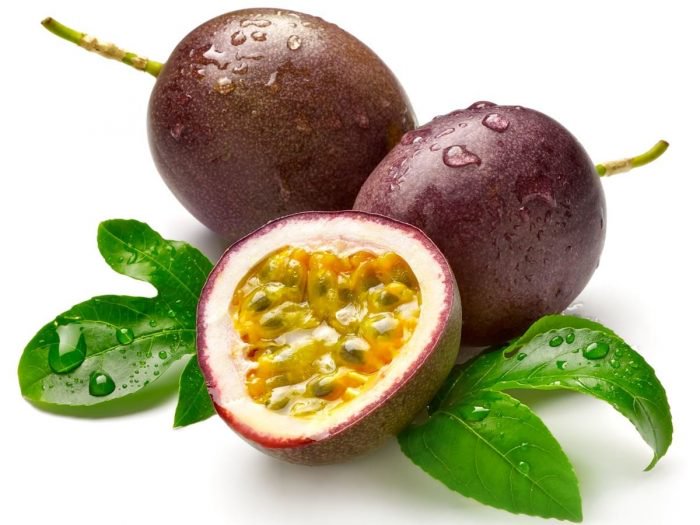
Passion Fruit (Passiflora edulis)
Passiflora edulis is a vine species of passion flower that is native to southern Brazil through Paraguay to northern Argentina. Its common names include passion fruit or passionfruit (English), maracujá (Portuguese) maracuyá or parcha (Spanish), grenadille or fruit de la passion (French) and lilikoʻi (Hawaiian). It is cultivated commercially in tropical and subtropical areas for its sweet, seedy fruit. The passion fruit is a pepo, a type of berry, round to oval, either yellow or dark purple at maturity, with a soft to firm, juicy interior filled with numerous seeds.[1][3] The fruit is both eaten and juiced; passion fruit juice is often added to other fruit juices to enhance aroma.
Description
There are two varieties in the vine species of Passiflora edulis. One is a shallow-rooted, woody, perennial that possesses many tendrils. The other variety is deeply-rooted. The young tendrils are finely-toothed and typically have a red or purple hue. Usually the vine produces a single flower 5–7.5 cm wide at each node. The flower has 5 oblong, green sepals and 5 white petals. The sepals and petals are 4-6mm in length and form a fringe. The base of the flower is a rich purple with 5 stamens, an ovary, and a branched style. The styles bend backward and the anthers, which are located on top of the styles, have a very distinct head. The berry produced is fleshy and spherical. It is 1–1.4 cm long and 9–13 mm thick with a thick layer of pith. The outside color of the berry ranges from hues of dark-purple to black with fine white specks light yellow in color. Within the berry, there are typically 250 black seeds, each 2.4 mm in length. Each seed is surrounded by a membranous sac filled with pulpy juice. The flavor of the juice is slightly acidic and musky. The passion fruit's flavor can be compared to that of the guava fruit.
Nutrition
Raw passion fruit is 73% water, 22% carbohydrates, 2% protein and 0.7% fat. In a 100 gram amount, fresh passion fruit contains 36% of the Daily Value (DV) of vitamin C, 42% dietary fiber, B vitamins riboflavin (11% DV) and niacin (10% DV), 12% iron and 10% phosphorus (right table). No other micronutrients are in significant content.
Nutritional value per 100 g (3.5 oz)
| Energy | 406 kJ (97 kcal) | |
|---|---|---|
| Carbohydrates | 22.4 g | |
| Sugar | 11.2 g | |
| Dietary fiber | 10.4 g | |
| Fat | 0.7 g | |
| Protein | 2.2 g | |
| Vitamins | ||
| Vitamin A equiv. | 64 μg | (8%) |
| beta-Carotene | 743 μg | (7%) |
| Riboflavin (B2) | 0.13 mg | (11%) |
| Niacin (B3) | 1.5 mg | (10%) |
| Vitamin (B6) | 0.1 mg | (8%) |
| Folate (B9) | 14 μg | (4%) |
| Choline | 7.6 mg | (2%) |
| Vitamin C | 6.4 mg | (8%) |
| Vitamin D | 0.7 μg | (1%) |
| Minerals | ||
| Calcium | 12 mg | (1%) |
| Iron | 1.6 mg | (12%) |
| Magnesium | 29 mg | (8%) |
| Phosphorus | 68 mg | (10%) |
| Potassium | 348 mg | (7%) |
| Sodium | 28 mg | (2%) |
| Zinc | 0.1 mg | (1%) |